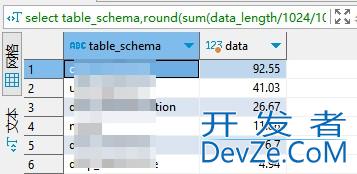Redis之如何实现用户关注
目录
- Redis实现互相关注功能
- 功能要求
- Redis存储结构设计
- 后端实现
- 添加关注
- 取消关注
- 查看关注对象
- 前端实现
- 添加关注和取消关注操作
- 显示关注和被关注数量
- 总结
Redis实现互相关注功能
在实现社交网络功能中,实现互相关注是必不可少的。在这里,我们将使用Redis来实现这个功能,前端使用vue框架实现。
功能要求
我们需要实现以下几个功能:
- 用户能够关注其他用户
- 用户能够取消关注其他用户
- 用户能够查看自己关注的人和被谁关注
- 在用户的主页上,能够显示关注和被关注的数量
Redis存储结构设计
我们使用Redis的set数据结构来存储用户关注的人和被关注的人。
具体来说,每个用户都有一个following和followers属性,分别表示该用户关注的人和www.devze.com被谁关注。
然后在Redis中使用set类型来存储这些关注信息,在set中,我们将每个关注对象的id存储下来,方便后续的查询。
后端实现
添加关注
我们需要通过API来让用户实现添加关注和取消关注。
下面是添加关注的API代码:
// 添加关注
router.post('/followers/:id', async (req, res) => {
try {
const followerId = req.user.id;
const followingId = req.params.id;
// 获取被关注的用户和关注该用户的用户
const following = await User.findById(followingId);
const follower = await User.findById(followerId);
// 添加关注对象
await redis.sadd(`user:${followerId}:following`, followingId);
await redis.sadd(`user:${followingId}:followers`, followerId);
res.json({ message: `You are now following ${following.username}` });
} catch (error) {
console.error(error.message);
res.status(500).send('Server Error');
}
});
在这个代码中,我们使用了redis.sadd方法将关注对象的id添加到set中。
取消关注
接下来是取消关注的API代码:
// 取消关注
router.delete('/followers/:id', async (req, res) => {
try {
const followerId = req.user.id;
const followingId = req.params.id;
// 获取被取消关注的用户和取消关注该用户的用户
const following = await User.findById(followingId);
const follower = await User.findById(followerId);
// 删除关注对象
await redis.srem(`user:${followerId}:following`, followingId);
await redis.srem(`user:${followingId}:followers`, followerId);
res.json({ message: `You have unfollowed ${following.username}` });
} catch (error) {
console.error(error.message);
res.status(500).send('Server Error');
}
});
这个代码与添加关注的代码类似,只是使用了redis.srem方法来将关注对象的id从set中删除。
查看关注对象
最后,我们需要实现查看关注对象的API。这个API需要分别获取关注和被关注的set,然后将id转换为用户对象。
// 获取关注和粉丝
router.get('/followers', async (req, res) => {
try {
const userId = req.user.id;
// 获取关注和被关注的set
const [following, followers] = await Promise.all([
redis.smembers(`user:${userId}:following`),
redis.smembers(`user:${user编程Id}:followers`),
]);
// 将id转换为用户对象
const followingUsers = await Promise.all(
following.map((id) => User.findById(id))
);
const followerUsers = await Promise.all(
followers.map((id) => User.findById(id))
);
res.json({ following: followingUsers, followers: followerUsers });
} catch (error) {
console.error(error.message);
redGpSwVs.status(500).send('Server Error');
}
});
前端实现
在前端中,我们使用Vue框架来实现。需要提供以下功能:
- 用户可以通过点击按钮来添加和取消关注操作
- 用户的主页可以显示关注和被关注的数量
添加关注和取消关注操作
在Vue中,我们可以使用@click监听用户点击事件,并在方法中发送API请求来进行添加和取消关注。
下面是代码示例:
<!-- 添加关注 --> <button @click="followUser(user._id)" v-if="!isFollowing(user._id)">关注</button> <!-- 取消关注 --> <button @click="unfollowUser(user._id)" v-else>取消关注</button>
methods: {
// 添加关注
async followUser(id) {
await axIOS.post(`/api/followers/${id}`);
// 更新关注状态
this.isFollowingUsers[id] = true;
},
// 取消关注
async unfollowUser(id) {
await axios.delete(`/api/followers/${id}`);
// 更新关注状态
this.isFollowingUsers[id] = false;
},
// 判断是否关注
isFollowing(id) {
return this.isFollowingUsers[id];
}
}
在这个代码中,我们使用了isFollowingUsers对象来存储所有用户的关注状态。
显示关注和被关注数量
为了在用户的主页上显示关注和被关注的数量,我们需要在后端添加相应的API,并在前端调用数据显示。
下面是相关代码:
// 获取关注和粉丝数量
router.get('/followers/count', async (req, res) => {
try {
const userId = req.user.id;
// 获取关注和被关注数量
const [fo编程llowingCount, followerCount] = await Promise.all([
redis.scard(`user:${userId}:folljsowing`),
redis.scard(`user:${userId}:followers`),
]);
res.json({ followingCount, followerCount });
} catch (error) {
console.error(error.message);
res.status(500).send('Server Error');
}
});
<!-- 显示关注和被关注数量 -->
<div>
<p>关注 {{followingCount}}</p>
<p>被关注 {{followerCount}}</p>
</div>
在这个代码中,我们使用了redis.scard方法来获取set的数量。
总结
以上就是使用Redis实现互相关注功能的全部内容。通过使用Redis的set数据结构来存储关注对象,方便高效地进行添加和取消关注操作。同时,在前端中使用Vue框架实现了可交互的关注和取消关注按钮,并在用户主页上显示了关注和被关注的数量。
这些仅为个人经验,希望能给大家一个参考,也希望大家多多支持编程客栈(www.devze.com)。








 加载中,请稍侯......
加载中,请稍侯......
精彩评论